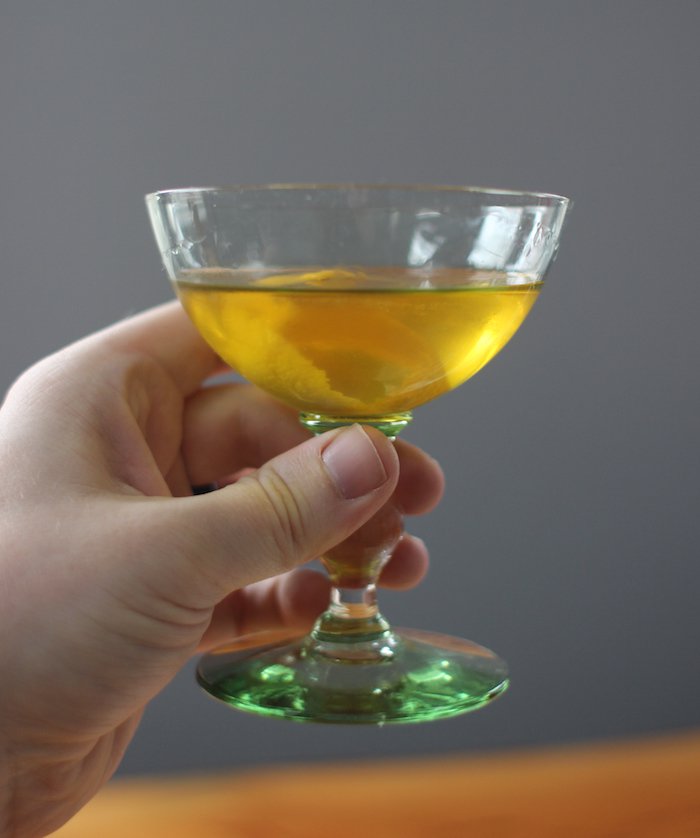
One of James Bond’s most enduring catchphrases is “shaken, not stirred.” But what, exactly, is being mixed in that cocktail shaker? Most of us know that it’s a martini of some sort, but that cocktail has evolved in such numerous ways over the decades, can we really know the specific type of martini that Bond indulges in?
We can if we dig into Ian Fleming’s very first novel about the world’s most famous spy: Casino Royale (the recipe was mentioned in the 2006 film adaptation of the book as well). In the story, Fleming tells us, through Bond himself, the exact recipe for the Vesper martini (an old word for evening, as well as the name of an alluring female Secret Service agent with whom 007 works on this case):
“A dry martini. One. In a deep champagne goblet. . . . Three measures of Gordon’s, one of vodka, half a measure of Kina Lillet. Shake it very well until it’s ice-cold, then add a large thin slice of lemon peel. Got it?”
If you know cocktails, you know that’s quite a strong drink (a “measure” can either mean 1 or 1.5 US ounces, depending on the establishment). It’s between 4-6 oz of hard liquor, plus that extra half measure of Lillet (an apertif, fortified wine; i.e., a beverage meant to be consumed before dinner to stimulate the appetite). That’s at least two times the amount of booze contained within your average cocktail.
The bartender in the novel notices this fact and responds, “Gosh, that’s certainly a drink.” To which Bond explains, “I never have more than one drink before dinner. But I do like that one to be large and very strong and very cold and very well-made. I hate small portions of anything.”
Interestingly enough, Casino Royale is in fact the only time Fleming has Bond order a Vesper; in the other books he drinks regular vodka and gin martinis. But 007 gave the recipe with such inedible conviction, that it’s become an enduring part of popular culture.
If you’d like to move beyond merely hearing about the Bond martini to actually tasting it, today I’ll go through all the ingredients you’ll need, as well as how to make it with your home bar.
If you’re ready to harness your inner secret agent, and gain a bit more savoir faire, it’s time to learn how to make a Vesper.
The Ingredients

While the Vesper is often classified as a martini, it really defies categorization. A classic martini contains gin, dry vermouth, and an olive or two. A vodka martini simply replaces the gin with vodka.
Bond uniquely combines the two spirits, and instead of using vermouth, he requests Kina Lillet. And rather than olives, Bond uses lemon peel as a garnish. It’s a drink as unique as 007 himself. Let’s briefly discuss the individual ingredients before we get into properly mixing the cocktail.
Gordon’s. Gordon’s is a brand of dry gin that’s been made in London since the late 1700s. (If you’re buying it in the U.S., however, it’s been made in either the States or Canada.) While it’s an inexpensive gin in today’s craft-obsessed market (my 1.75L bottle cost just $14 — a steal!), it accounts for over a third of Britain’s gin market, and is annually among the best-selling brands worldwide. Even snobby reviewers tend to give Gordon’s a fair shake and admit that it’s a quality product, especially at its low price point. Gordon’s Gin can be found at most liquor stores.
Vodka. Of the Vesper martini’s three alcohols, this is the only one for which Bond doesn’t specify a brand. He actually explains it in Casino Royale (the novel): “if you can get a vodka made with grain instead of potatoes, you will find it still better” — indicating that this version was made with a potato vodka. He then says, however, “Mais n’enculons pas des mouches” (a French phrase meaning “let’s not split hairs”). While Bond’s a man of impeccably good taste, he’ll also take what’s available to him — in terms of vodka, at least! For my home version, I went with New Amsterdam, a perfectly middle-of-the-road grain vodka made here in the US that I bought for about $20 (for a 750ml bottle).
A side note: back in the early ’50s when Fleming created the recipe, the standard ABV of vodka would have been closer to 50% (or 100 proof). Most of what you’ll find today on shelves is between 80 and 90 proof, but if you really want to recreate the original Vesper, look for a 100-proof vodka.
Kina Lillet. Here is where things get tricky. Lillet is a French brand of fortified wine that at one time contained quinine (the defining ingredient in tonic). In the late 1800s, “tonic wine” became rather popular and was marketed as a preventive beverage that would fight off fevers and malaria.
It remained popular for many decades, but by the 1970s and ‘80s, demand for quinquinas (beverages with quinine in them) had died down, and the company changed the recipe (and name — to Lillet Blanc), drastically reducing the amount of quinine. While there’s purportedly still some in the recipe, on its own, Lillet Blanc tastes mostly like a sweet white wine. It’s as close as you’ll get to the original Vesper mixer, however, and it can be found with vermouths and other apertifs in most liquor stores for about $20 for a 750ml bottle.
Cinchona-infused liquor. So where will we get that distinct quinine flavor? We can’t just add tonic; that would water down the beverage too much. So instead we make what is essentially our own quinine liquor. We do that by the simple process of mixing cinchona bark — where quinine comes from — with vodka (I used the New Amsterdam that I bought for this recipe). You likely won’t be able to easily find cinchona bark, so order it online. A pound was about $20, and you’ll get many batches of infused liquor from that amount.

Since vodka is a neutral spirit — that is, it doesn’t have a ton of flavor on its own — it’s particularly good at absorbing other flavors and is therefore perfect for making home infusions. I used a small handful of cinchona bark — slightly less than 1/4 cup — and mixed it with about 6oz of vodka in a mason jar. I let it sit for about 24 hours, and it ended up with a wonderful quinine aroma and a deep golden hue. Filter it through cheesecloth (or a coffee filter), keep it stored in the mason jar, and you have quinine liquor for use in your evening Vespers!
Lemon. Any lemon will do; I used a serrated paring knife to cut a “large thin slice of lemon peel” as directed by Bond himself.
How to Make a Classic James Bond Vesper Martini

As Bond famously noted, this cocktail is to be very well shaken until ice cold. It’s generally accepted nowadays that this was foolish from a mixologist’s perspective. Shaken drinks tend to be those that include juice, egg whites, or cream; cocktails with those ingredients need to be very well incorporated, and even a little frothy. Cocktails that include purely alcoholic ingredients should rather be stirred in a glass of ice then strained out into your glass, as shaking will make the drink cloudy and can excessively water it down, as the shaking melts the ice.
Perhaps Bond thought that shaking would chill the cocktail quicker (he does prefer his pre-dinner drinks “very cold,” after all), and actually liked it a bit watered down, given how strong it is. We’ll never know, but since 007 insisted on shaking, that’s what we’re going to do too!
- Peel your lemon and place it in the glass first. When you pour the drink, this allows the essence of the peel to be more evenly incorporated throughout the drink rather than just plopping it in at the end.
- Fill your shaker with ice.
- Add all liquid ingredients to the shaker. Rather than making the uber-boozy drink that Bond requested, I did half measures. Since the recipe is listed in parts rather than specific measurements, it’s easily scalable. The cocktail is still plenty strong, don’t worry. Of course, if you’re feeling plucky, feel free to go with Bond’s full measures. (Just don’t drive afterwards, or get in a fight with a member of the KGB!)
- 1.5 oz Gordon’s Gin
- .5 oz vodka (again, preferably a grain vodka)
- .25 oz Lillet Blanc
- 2 dashes cinchona-infused liquor — I know this is terribly unspecific; I poured a couple small dashes directly from the mason jar and it was perfect
- Shake it up! Hold the shaker in both hands and vigorously shake the cocktail for a slow count to 10, or until the outside of the shaker gets cold and frosty.
- Pour into your champagne glass and enjoy! Interestingly, Bond requests a champagne goblet as his vessel rather than a standard cocktail glass with a stem and wide triangular bowl. I’ve always thought those types of glasses to be a bit feminine, and I was glad to find that Bond seemed to agree! I used an antique champagne saucer that still had a stem (which is important so that the drink stays chilled while you’re holding it), but a wide, slightly shallow and rounded bowl.
My Review

I have to honestly say that this was the best martini I believe I’ve had (I know I said above that it’s not really a martini, but it’s what folks call it, so I’m stickin’ with it). I’m not much of a vodka fan, so vodka martinis don’t do anything for me. And while a classic gin martini is okay, I don’t enjoy the olives that typically come with it, and it’s quite stiff. The Vesper, with its Lillet and quinine infusion, has a bit of sweetness that perfectly offsets the slightly bitter character of the dry gin. And the vodka adds an extra flavor that can only be described as “booziness” that is rather unique and enjoyable in a gin-based cocktail.
While I’m still largely a whiskey man, I can see the Vesper popping up in my mix of homemade cocktails to make for special evenings with friends and family. To say you’re making the classic Bond martini is sure to not only enliven the environment, but provide superb conversation fodder as well!
The post How to Make the Classic James Bond Vesper Martini appeared first on The Art of Manliness.
(via The Art of Manliness)






